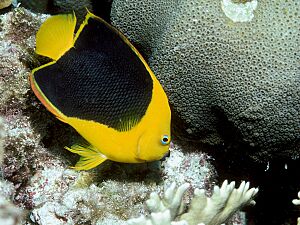Rock beauty facts for kids
Quick facts for kids Rock beauty |
|
|---|---|
 |
|
| Conservation status | |
| Scientific classification | |
| Synonyms | |
|
The rock beauty (Holacanthus tricolor) is a super colorful fish. It's a type of marine angelfish that lives in the ocean. People sometimes call it by other names like corn sugar or yellow nanny. You can find this beautiful fish in the western part of the Atlantic Ocean.
Contents
What Does It Look Like?
The rock beauty fish has a body shaped like a deep oval. It's also quite flat from side to side. It has a short nose and a small mouth. Inside its mouth are teeth that look like tiny brushes.
There's a big spine near its gill cover. Young rock beauties are mostly yellow. They have a black spot with a blue edge on their back. As they get older, this black spot grows much bigger. It can cover most of their body!
The front part of the adult fish, including its head, stays yellow. Its front fins, bottom fins, and tail fin are also yellow. Its mouth is purple. The edges of its bottom fin and gill cover are orange. The top and bottom parts of its eye have a bright blue color.
This fish has 14 spines and 17 to 19 soft rays on its top fin. Its bottom fin has 3 spines and 18 to 20 soft rays. The rock beauty can grow up to 30 centimeters (about 12 inches) long.
Where Does It Live?
The rock beauty lives in the Western Atlantic Ocean. You can find it from Bermuda down to Florida and along the coasts of South America, all the way to Rio de Janeiro.
It's not very common in the Gulf of Mexico. There, you might only see it near the Flower Gardens Banks off Texas or near Veracruz in Mexico.
Its Home and Habits
You can find the rock beauty living in water from 3 to 92 meters (about 10 to 300 feet) deep. They like to hang out around rocky reefs and coral reefs. Young rock beauties often hide in areas with fire coral.
These fish mostly eat sponges. But they also munch on corals, small sea animals called zoantharians, and tiny creatures called bryozoans. They also eat gorgonians (like sea fans), tunicates (sea squirts), and algae.
Adult rock beauties usually swim around in pairs. They seem to stay together for a long time, like a married couple! Often, one fish in the pair is bigger than the other. This might mean males and females are different sizes.
Life Cycle and Reproduction
When it's time to lay eggs, the male and female rock beauty swim up into the water. They stay close together while releasing their eggs and sperm. A female can lay between 25,000 and 75,000 eggs in one evening! Over a whole season, she might lay up to 10 million eggs.
The eggs are clear and float in the water. They hatch after about 15 to 20 hours. When they first hatch, the baby fish (called larvae) have a big yolk sac. They don't have working eyes, a gut, or fins yet.
After about two days, the yolk is gone. The larvae start to look more like tiny fish. They eat tiny floating plants and animals called plankton. They grow very fast! After about 3 to 4 weeks, they settle down onto the ocean floor.
Rock beauties are very protective of their space. But unlike some other angelfish, they don't clean other fish.
Popularity
The rock beauty is a very popular fish for home aquariums. Many people love to keep them because of their bright colors. In recent years, it has become possible to buy rock beauties that were born and raised in captivity.


